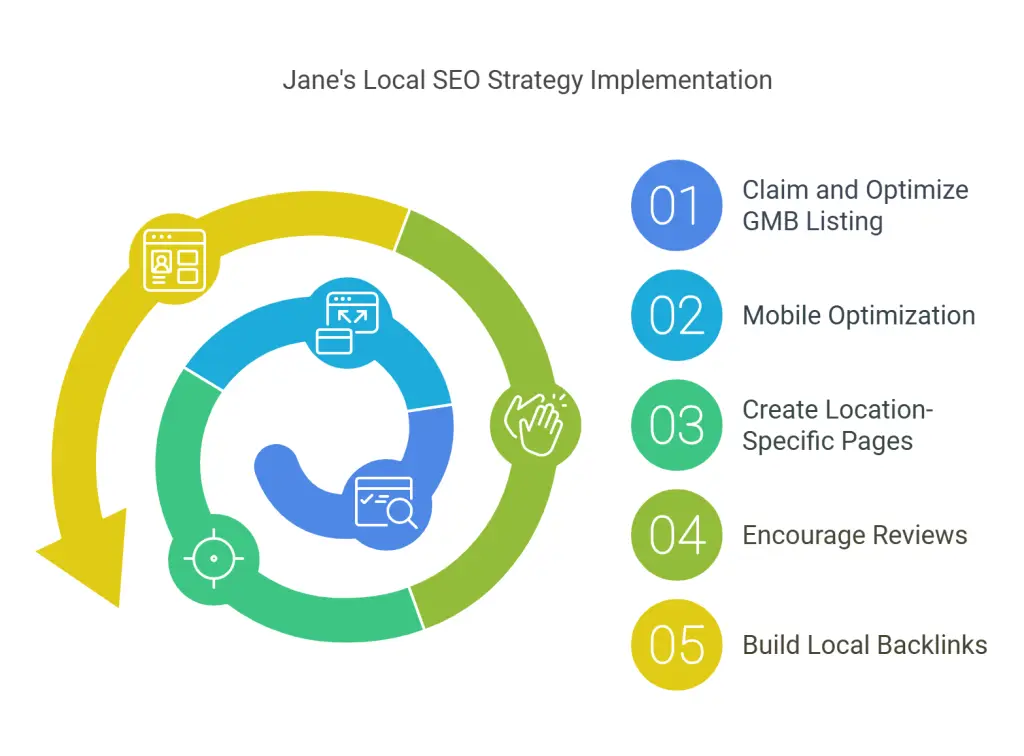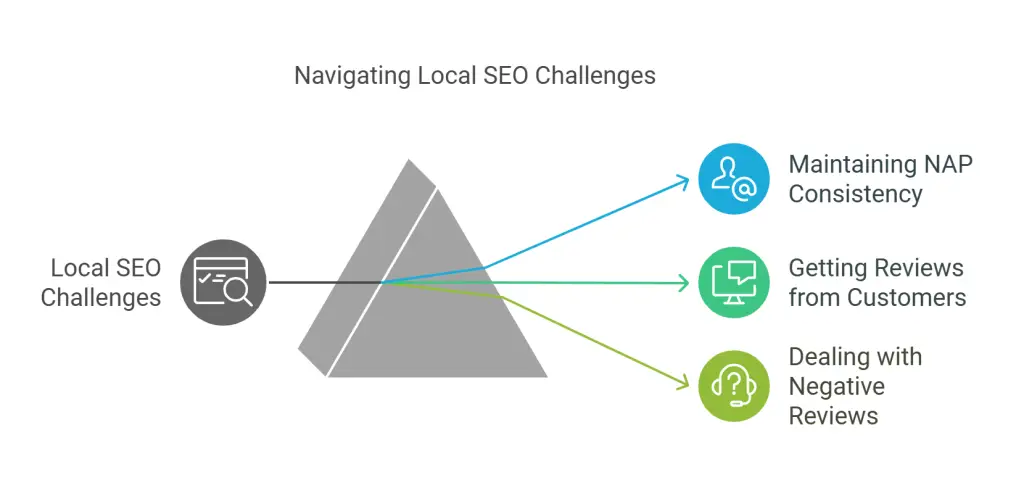Service-based businesses need to maintain a strong online presence to stand out from the competition and attract new customers. Gone are the days when a simple flyer or word of mouth was enough to grow your business—customers now turn to search engines to find services nearby. For small, local businesses, this presents a unique opportunity. By leveraging Local SEO (Search Engine Optimization), you can not only increase visibility online but also bring more foot traffic to your physical location or direct more leads to your service offerings.
In this blog post, we’ll dive into the importance of Local SEO, how it works, and how you can implement actionable strategies to grow your service-based business. Whether you’re a plumber, a landscaper, a hair salon owner, or a personal trainer, this guide will equip you with the tools you need to unlock the power of Local SEO and grow your business.
Why Local SEO is Crucial for Service-Based Businesses
Before we get into the strategies, it’s essential to understand why Local SEO is so important, especially for service-based businesses.
1. Local SEO Targets the Right Audience
Unlike general SEO, which focuses on ranking on a national or global scale, Local SEO hones in on searchers in your geographic area. This is particularly useful for service-based businesses that rely on local customers. For instance, if you own a plumbing service in Chicago, you want people in Chicago—not New York—to find your business when they search for a plumber.
2. Increases Online Visibility and Foot Traffic
Local SEO enhances your business’s online visibility by increasing its ranking in local search results, particularly in Google’s local pack (those top three local businesses displayed prominently at the top of the results). When potential customers search for services in their area, having a well-optimized Local SEO strategy ensures that your business appears at the top, increasing the chances that they will choose your services.
3. Mobile Users are the New Power Players
More than 60% of searches are now conducted via mobile devices, and these searches are typically local. “Plumber near me,” “best hair salon near me,” or “landscaping services in [city]” are common search queries. If you aren’t optimizing your website for local searches, you are missing out on a massive number of potential customers who are looking for services on the go.
4. Local SEO Helps Build Trust and Authority
A high ranking in local search results improves your visibility and builds trust with potential customers. Appearing in Google’s local pack, for example, shows that your business is trusted by the search engine and relevant to the user’s query. Additionally, you establish credibility and reliability by optimizing customer reviews and ensuring accurate business listings.

How Local SEO Works: The Basics
Local SEO isn’t just about adding keywords like “near me” to your website content. It’s a comprehensive approach that focuses on numerous ranking factors to ensure your business is favored in local search results.
1. Google My Business (GMB) Optimization
One of the first steps in any Local SEO strategy is claiming and optimizing your Google My Business (GMB) listing. GMB is Google’s free business listing that allows businesses to appear in local search results and Google Maps. An optimized GMB profile will increase your chances of being featured in the local pack.
How to Optimize Your GMB Listing:
- Claim your GMB listing: Visit Google My Business and claim your business if you haven’t done so already.
- Complete all fields: Ensure that all sections of your profile are filled in, including your business name, address, phone number, website URL, and hours of operation.
- Add keywords: In your business description, incorporate relevant keywords that your target audience might search for.
- Choose the right categories: Ensure you select the correct business category. For instance, if you are a plumber, don’t simply choose “service provider” as your category—use the more specific “plumber.”
- Post updates: GMB allows you to post updates, promotions, or special offers that can keep your profile active and engaging.
- Get reviews: Encourage satisfied customers to leave positive reviews, as reviews are a significant ranking factor in Local SEO.

2. NAP Consistency
NAP stands for Name, Address, and Phone Number, and it’s crucial for ensuring consistency across all online platforms. Your NAP should be identical on your website, social media profiles, local business directories, and any other online mentions. Inconsistent information can confuse potential customers and harm your local SEO rankings.
3. Citations and Listings
A citation is an online mention of your business’s NAP. Building local citations helps your business rank higher in local search results. Citations can be found on local business directories, review sites, social media platforms, and industry-specific directories.
Top citation sources include:
- Yelp
- Yellow Pages
- Bing Places
- Apple Maps
4. Localized Content and Keywords
To rank for local search queries, you need to incorporate local keywords into your content. This includes using geo-specific phrases like “plumbing services in Dallas” or “best landscaping company in San Diego.” It’s not just about stuffing keywords—it’s about creating useful, location-specific content that serves your audience’s needs.
For example:
- Blog posts: Write about local events or trends related to your services, such as “How to Prepare Your Home for Winter: Tips from a Denver Plumber.”
- Service pages: Create separate landing pages for each of your service locations with localized content.
- Case studies: Showcase success stories of services you’ve provided to clients in specific areas.

Actionable Local SEO Strategies for Service-Based Businesses
Now that you understand the importance of Local SEO and its key components, let’s look at actionable strategies to implement in your business.
1. Optimize for Mobile
Mobile optimization is non-negotiable. Make sure your website is responsive and loads quickly on mobile devices. Since many local searches are made via smartphones, ensuring a smooth mobile experience increases the likelihood that users will stay on your website and book your services.
2. Create Location Pages
If your service-based business operates in multiple cities or regions, creating location-specific pages can help target local customers more effectively. Each page should contain:
- A unique URL: For example, “yourbusiness.com/plumbing-san-francisco”
- Localized content: Include details relevant to that area, such as testimonials from local clients.
- Google Maps embed: Make it easy for users to find your business.
3. Leverage Online Reviews
Reviews are a massive factor in local SEO rankings. Encourage satisfied customers to leave reviews on your GMB listing, Yelp, or other relevant platforms. Positive reviews build trust and influence potential customers, helping your SEO efforts.
Tips for Encouraging Reviews:
- Ask politely: After completing a service, kindly request that your customer leave a review.
- Make it easy: Provide direct links to your Google My Business, Yelp, or Facebook review page in follow-up emails.
- Respond to reviews: Whether positive or negative, always respond to customer reviews to show that you care about their experience.

4. Build Local Backlinks
Backlinks are one of the most important ranking factors for SEO. By obtaining backlinks from reputable, local websites, you can increase your domain authority and improve your local search rankings.
Where to Get Local Backlinks:
- Local business directories: Ensure your business is listed on relevant local directories.
- Collaborate with local influencers: Partner with local bloggers, influencers, or media outlets to feature your business.
- Sponsor local events: Sponsorships often come with backlinks from event websites.
- Join local chambers of commerce: Memberships often provide a listing on their website with a link back to yours.

5. Optimize Your Website for Local Search Terms
Ensure your website is optimized with local search terms that match the way people search for your services. This means not just general industry terms but also geo-specific ones. Use tools like Google’s Keyword Planner or Ubersuggest to find relevant keywords.
For example:
- Instead of just targeting “roofing services,” optimize for “roofing services in Austin.”
- Use long-tail keywords such as “best affordable plumber in Seattle” to target more specific queries.
Case Study: How Jane’s Cleaning Services Grew with Local SEO
To bring these concepts to life, let’s look at a fictional case study of how Jane, the owner of Jane’s Cleaning Services, used Local SEO to grow her business.

Background:
Jane had been running a small cleaning service in Atlanta for five years. She relied mostly on word of mouth for new clients, but her business growth had plateaued. Jane knew she needed more online visibility, especially since many of her competitors were popping up in search results while her business was largely invisible.
Challenges:
Jane faced several challenges:
- No Google My Business Listing: She hadn’t claimed her GMB listing, meaning her business wasn’t showing up in local search results.
- Outdated Website: Her website was not mobile-friendly, and her service areas were unclear.
- Few Online Reviews: While Jane had many satisfied clients, very few of them had left online reviews.
- Lack of Local Content: Her website content was generic and didn’t target her service areas.

Strategies Implemented:
Jane implemented several Local SEO strategies:
- Claimed and optimized her GMB listing: She added her business details, selected the right category, uploaded photos of her cleaning services, and began posting updates about her business.
- Mobile Optimization: Jane revamped her website to be mobile-friendly and ensured it loaded quickly on all devices.
- Created Location-Specific Pages: She created separate landing pages for each of her service areas—such as “Residential Cleaning in Buckhead” and “Office Cleaning in Midtown Atlanta.”
- Encouraged Reviews: Jane reached out to her past clients with a friendly email requesting reviews, which boosted her online reputation.
- Built Local Backlinks: Jane partnered with a local home improvement blogger, who wrote a feature on her services. This helped her earn a valuable local backlink and increase traffic to her site.

Results:
Within six months, Jane’s Cleaning Services experienced a significant increase in business:
- Her GMB listing began showing up in the local pack for search queries like “house cleaning services in Atlanta.”
- The mobile optimization and local pages resulted in a 40% increase in website traffic.
- Jane received 50 new customer reviews, with an average rating of 4.8 stars, which further boosted her local search ranking.
- Her revenue increased by 30%, thanks to the influx of new customers who found her business through local search.

Common Local SEO Challenges and How to Overcome Them
1. Maintaining NAP Consistency
Challenge: Managing consistent NAP information across all platforms can be tedious and prone to errors.
Solution: Use tools like Moz Local or BrightLocal to manage citations and ensure your NAP information is consistent everywhere online.
2. Getting Reviews from Customers
Challenge: Encouraging customers to leave reviews can be difficult, especially if they are not familiar with the process.
Solution: Make it easy for customers by providing direct links to review platforms. You can also incentivize reviews with a small discount on their next service or a thank-you gift.
3. Dealing with Negative Reviews
Challenge: Negative reviews can harm your reputation and affect your Local SEO ranking.
Solution: Respond to negative reviews professionally and promptly. Address the customer’s concerns and offer to rectify the issue. A well-handled negative review can turn a dissatisfied customer into a loyal one.

Conclusion: Unlock Your Business’s Potential with Local SEO
For service-based businesses, Local SEO is one of the most powerful tools available to attract new customers and grow your business. By optimizing your online presence with Google My Business, consistent NAP information, customer reviews, and localized content, you can rise above your competitors in local search results and turn online visibility into real-world growth.
Start by assessing where your Local SEO efforts currently stand, then implement the strategies discussed in this post to improve your online presence. The more effort you put into optimizing your local SEO, the greater your reward will be in terms of increased leads, foot traffic, and revenue.
Frequently Asked Questions
How does Local SEO help businesses attract more customers?
Local SEO improves visibility in geographically relevant searches, helping businesses attract nearby customers. By optimizing for local keywords, Google My Business, and online reviews, businesses can rank higher in local search results and drive more traffic to their website or storefront.
Why is optimizing Google My Business crucial for Local SEO?
A well-optimized Google My Business (GMB) profile boosts local rankings by providing accurate business information, photos, and customer reviews. GMB listings appear in Google’s Local Pack and Maps, making them a key factor in helping potential customers find and trust your business.
How do customer reviews impact Local SEO rankings?
Reviews play a major role in local search rankings by influencing trust and credibility. Google prioritizes businesses with positive, frequent reviews. Encouraging satisfied customers to leave feedback and responding to reviews helps improve rankings and attracts more local customers.
What role does mobile optimization play in Local SEO?
Since most local searches happen on mobile devices, a mobile-friendly site is critical. Google favors fast-loading, responsive websites that provide a seamless experience. Poor mobile optimization can reduce engagement and rankings, making it harder for customers to find local businesses.
Why is consistent NAP (Name, Address, Phone Number) important for Local SEO?
Consistent NAP details across websites, directories, and social media help search engines verify business legitimacy. Inconsistent information confuses customers and harms rankings. Maintaining accuracy across platforms strengthens local search visibility and builds trust with potential customers.
Further reading
Enge, Eric, Stephan Spencer, and Jessie Stricchiola. The Art of SEO: Mastering Search Engine Optimization. 3rd ed. Sebastopol, CA: O’Reilly Media, 2015. https://www.amazon.com/Art-SEO-Mastering-Search-Optimization/dp/1491948965/
Clarke, Adam. SEO 2021: Learn Search Engine Optimization with Smart Internet Marketing Strategies. CreateSpace Independent Publishing Platform, 2021. https://www.amazon.com/SEO-2021-Learn-Search-Optimization/dp/1913587249/
Marshall, Perry, and Talor Zamir. Ultimate Guide to Local Business Marketing. Locomotive Press, 2018. https://www.amazon.com/Ultimate-Guide-Local-Business-Marketing/dp/0989662609/
Jantsch, John, and Phil Singleton. SEO for Growth: The Ultimate Guide for Marketers, Web Designers & Entrepreneurs. Page Street Publishing, 2016. https://www.amazon.com/SEO-Growth-Ultimate-Marketers-Entrepreneurs/dp/0998493708/
Moz. “The Beginner’s Guide to SEO.” Moz. Accessed January 8, 2025. https://moz.com/beginners-guide-to-seo
Dean, Brian. “Local SEO Ranking Factors: The Ultimate Guide.” Backlinko. Last modified 2023. https://backlinko.com/local-seo-ranking-factors
Patel, Neil. “How to Do Local SEO [Updated for 2023].” YouTube video, 22:40. Neil Patel. YouTube, September 15, 2023. https://www.youtube.com/watch?v=Yq_xb3NR0FI
Google My Business. “Google My Business Tutorial: How to Create & Manage Your Google Business Profile.” YouTube video, 11:30. Google My Business. YouTube, January 12, 2020. https://www.youtube.com/watch?v=abcdef12345
Eder, Braden. “10 Local SEO Tips for Small Businesses in 2023.” Search Engine Journal, January 2023. https://www.searchenginejournal.com/local-seo-tips/
Hines, Kristi. “Local SEO: A Complete Guide to Master Local Marketing.” WebFX, March 2023. https://www.webfx.com/blog/marketing/local-seo/







